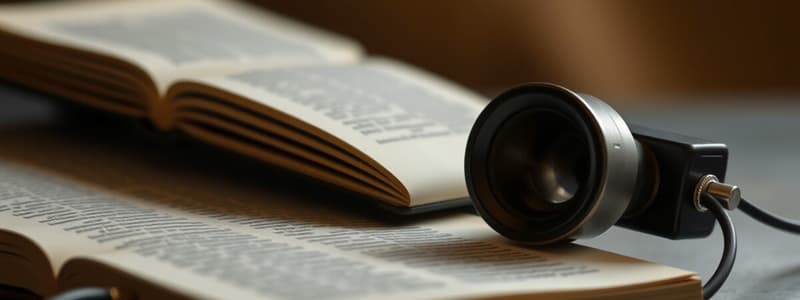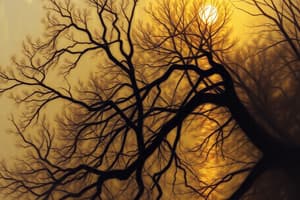Podcast
Questions and Answers
Match the sound devices with their definitions:
Match the sound devices with their definitions:
Rhyme = Repetition of words with the same sound Onomatopoeia = Replicates the exact sound of something Alliteration = Repeated letter sounds at the stressed part of words Assonance = Repetition of vowel sounds in close proximity
Match the sound devices with their examples:
Match the sound devices with their examples:
Consonance = The 's' sound in 'whispering winds' Alliteration = The 'g' sound in 'glowing golden grains' Onomatopoeia = 'Buzz' to describe a bee Rhyme = 'Hat' and 'cat'
Match the sound devices with their characteristic:
Match the sound devices with their characteristic:
Alliteration = Focuses on initial consonant sounds Assonance = Focuses on vowel sounds Consonance = Involves repetition of consonant sounds Onomatopoeia = Imitates natural sounds
Match the sound devices with their purpose in poetry:
Match the sound devices with their purpose in poetry:
Match the sound devices with their examples based on usage:
Match the sound devices with their examples based on usage:
Match the sound devices with their unique characteristics:
Match the sound devices with their unique characteristics:
Match the sound devices with their descriptions:
Match the sound devices with their descriptions:
Match the sound devices with their effects in poetry:
Match the sound devices with their effects in poetry:
Match the following terms with their related elements of poetry:
Match the following terms with their related elements of poetry:
Match the sound devices with their examples:
Match the sound devices with their examples:
Match the poetic elements with their definitions:
Match the poetic elements with their definitions:
Match the devices with their descriptions:
Match the devices with their descriptions:
Match the following terms with their examples:
Match the following terms with their examples:
Match the elements of poetry with their characteristics:
Match the elements of poetry with their characteristics:
Match the components of poetry with their roles:
Match the components of poetry with their roles:
How does the form of a poem influence its overall impact on the reader?
How does the form of a poem influence its overall impact on the reader?
In what ways can imagery enhance the reader's experience of a poem?
In what ways can imagery enhance the reader's experience of a poem?
What role do sound devices play in creating the musicality of a poem?
What role do sound devices play in creating the musicality of a poem?
Explain how figurative language adds depth to poetry.
Explain how figurative language adds depth to poetry.
How does the theme of a poem shape its meaning and relevance?
How does the theme of a poem shape its meaning and relevance?
Flashcards are hidden until you start studying
Study Notes
Sound Devices in Poetry
- Rhyme involves the repetition of similar-sounding words, contributing to the poem's musical quality.
- A rhyme scheme refers to the specific pattern of rhymes used throughout the poem.
- Onomatopoeia mimics actual sounds related to objects or actions in the poem, enhancing imagery and emotional impact.
- Alliteration is the repetition of initial consonant sounds in close proximity, often highlighting key phrases (e.g. "glowing golden grains").
- Consonance refers to the repetition of consonant sounds at any position—beginning, middle, or end—within two or more lines of poetry.
- Assonance involves the repetition of vowel sounds within close proximity, adding to the auditory effects of the poem.
Sound Devices in Poetry
- Rhyme: Repetition of similar sounds in words, creating a rhyme scheme that contributes to the poem’s musicality.
- Onomatopoeia: Words that imitate the actual sounds associated with their meanings, enhancing the sensory experience.
- Alliteration: The repetition of initial consonant sounds in closely placed words, as seen in phrases like “glowing golden grains.”
- Assonance: Repetition of vowel sounds in nearby words, contributing to the poem’s auditory quality.
- Consonance: Repetition of consonant sounds at any position within words, creating harmony and rhythm in poetry.
Basic Elements of Poetry
- Form: The structure and design of a poem, which includes rhyme, rhythm, stanza arrangement, and visual layout on the page.
- Line: The foundational unit of poetry determined by length, rhythm, and positioning, affecting the poem's overall flow.
- Imagery: Use of descriptive language that evokes sensory experiences, enabling readers to visualize and feel the essence of the subject matter.
Figurative Language
- Enhances poetry by allowing poets to express ideas and emotions beyond literal meanings using techniques like metaphors, similes, personification, and hyperbole.
- Encourages imaginative interpretation and enriches the reader's experience of themes and emotions.
Theme
- Represents the central idea or message of a poem, often revealed through recurrent images, symbols, or motifs that provide deeper meaning.
Form
- Refers to the structural design of a poem, encompassing its overall assembly.
- Includes rhyme patterns, rhythm, stanza arrangement, and visual presentation on the page.
Line
- The fundamental unit of poetry characterized by length, rhythm, and page arrangement.
- Lines contribute to the poem's flow and meaning.
Imagery
- Descriptive language that engages the senses and creates vivid mental images for readers.
- Employs carefully selected words to evoke how things look, sound, feel, smell, or taste.
Sound Devices
- Techniques include rhyme, rhythm, alliteration, assonance, consonance, and onomatopoeia.
- Enhance the poem's musical quality and create auditory effects that enrich the reading experience.
Figurative Language
- Adds complexity and emotional depth by transcending literal meanings.
- Invites interpretation through metaphors, similes, personification, and hyperbole, enabling poets to express intricate ideas and feelings imaginatively.
Theme
- Represents the central idea or underlying message within a poem.
- Often conveyed through recurring images, symbols, and motifs, allowing readers to explore deeper meanings.
Form
- Refers to the structural design of a poem, encompassing its overall assembly.
- Includes rhyme patterns, rhythm, stanza arrangement, and visual presentation on the page.
Line
- The fundamental unit of poetry characterized by length, rhythm, and page arrangement.
- Lines contribute to the poem's flow and meaning.
Imagery
- Descriptive language that engages the senses and creates vivid mental images for readers.
- Employs carefully selected words to evoke how things look, sound, feel, smell, or taste.
Sound Devices
- Techniques include rhyme, rhythm, alliteration, assonance, consonance, and onomatopoeia.
- Enhance the poem's musical quality and create auditory effects that enrich the reading experience.
Figurative Language
- Adds complexity and emotional depth by transcending literal meanings.
- Invites interpretation through metaphors, similes, personification, and hyperbole, enabling poets to express intricate ideas and feelings imaginatively.
Theme
- Represents the central idea or underlying message within a poem.
- Often conveyed through recurring images, symbols, and motifs, allowing readers to explore deeper meanings.
Studying That Suits You
Use AI to generate personalized quizzes and flashcards to suit your learning preferences.




